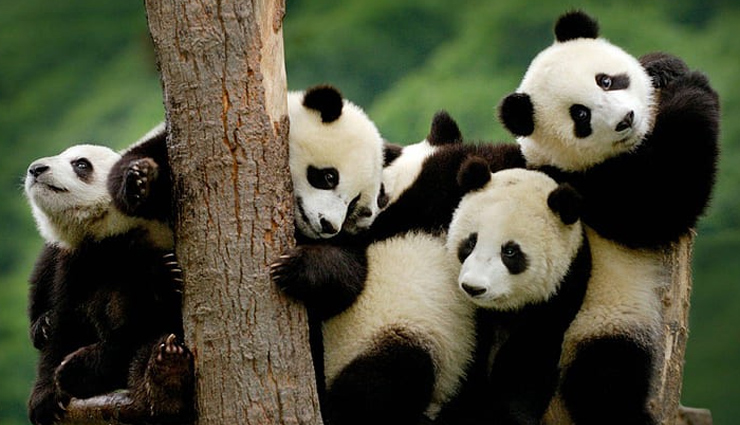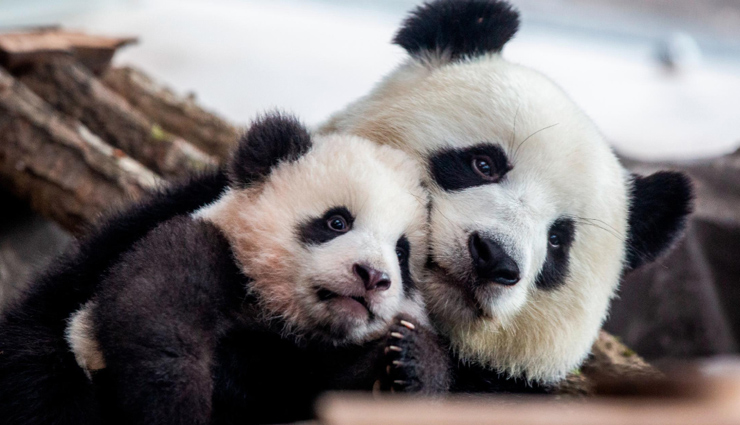10 Weird and Interesting Facts About Pandas

Giant Panda, reputed as “living fossil”, is the national treasure in China! You may know the adorable creature on earth is in black and white. But how many other facts do you know?
It is very necessary to do a little research no matter before you go to see the pandas or throw yourselves into a panda volunteer program. Check the following 10 interesting facts about giant pandas, helping you know further about their diet, habitat, behaviors, life span, weight, and living status.

* There are only “black” and “white” colors all over a panda’s body. The fur around their eyes, ears and feet is black. The rest of its fur is white in color.
Many Chinese philosophers think that the universe is made from two opposing forces - the Yin and Yang. Hence, the giant panda is the perfect example of this philosophy with its contrasting black and white fur. Furthermore, the gentle nature of this black and white creature brings peace and harmony when they are balanced.
* The World Wild Fund for Nature, short for WWF, is the world’s largest conservation organization, working in over 100 countries. It is is an international non-governmental organization founded in 1961, aim to work in the field of the wilderness preservation and reduce human impact on the environment.
The logo is the “giant panda” which was originated from a cute panda named Chi Chi that had been transferred from Beijing Zoo to London Zoo in 1958. WWF chose the the rare and recognizable physical features and statues of giant panda as an endangered species which stood for a strong symbol that would overcome all language barriers. WWF also needed an animal that would have an impact in black and white printing and while Panda is the perfect example.
Pandas in the wild will sometimes eat other grasses, wild tubers, or even meat in the form of birds, rodents, or carrion. Pandas in captivity may also eat honey, eggs, carrots, yams, fish, shrub leaves, apples, oranges or bananas, etc. For panda volunteers who do volunteering work at the pointed panda bases, they can experience the special time to learn how to make “panda cake” and of course, feed the specially-designed food in person.
* As you know, the main part of a panda’s daily life is bamboo, bamboo and bamboo. It means a panda bear should spend over 12 hours a day foraging and eating. The rest of its time is spent mostly sleeping and resting. They will sleep for 2 to 4 hours after eating. And then eat and sleep...
When you plan a visit to see pandas, it is highly recommended to visit the panda bases or zoos in the morning. Usually, they will start to eat around 08:00 when they are very active and panda lovers can enjoy a lot of fun!
* Giant pandas are so cute because their large cheeks, snub noses, and tottering gate remind us of human infants. Additionally, the dark patches over their eyes make their eyes appear larger, which also is similar to an infant's supersize eyes.
* The newborn baby panda is helpless and his/her mother devotes every waking moment to her baby. The young cubs are unable to crawl until they are three months old. They do not even open their eyes until about 45 days old. The cubs needs to be in a protected area like a den until it is 120 days old. At 14 month old, they try to eat solid foods, specially bamboo. They wean at around 18-24 months old and will leave to live a solitary life soon after. After that, their mom will prepare to breed the next baby
* Reputed as “Living Fossil” and “National Treasure”, the giant panda itself appeared suddenly during the late Pliocene or early Pleistocene, perhaps more than two to three million years ago. Panda fossils have been found in Burma, Vietnam, and particularly in Western China.
* Giant Panda has a long life span. On average a panda living in the wild can live around 20 years and giant panda in captivity lives on average for between 25 - 35 years. A female panda called “Jia Jia” lived in Hong Kong Ocean Park was the oldest panda bear ever in captivity, born in 1978 and died at an age of 38 (more than 100 years old in human terms) on October 16, 2016.